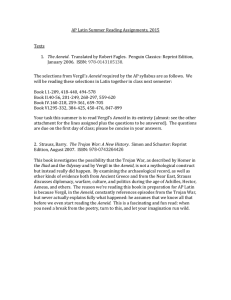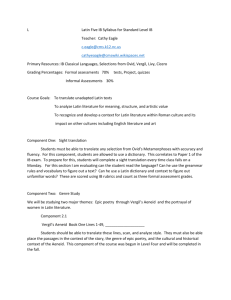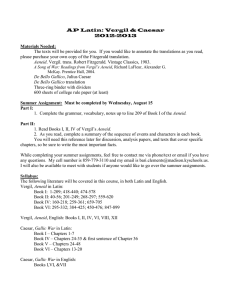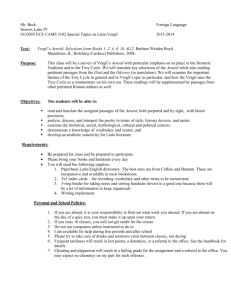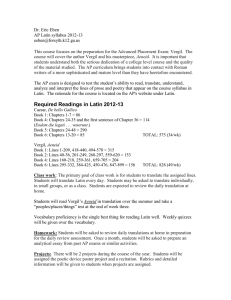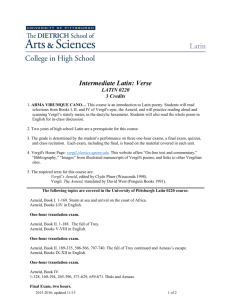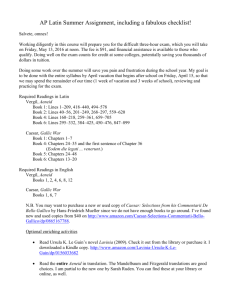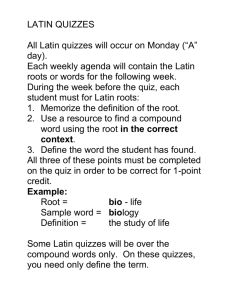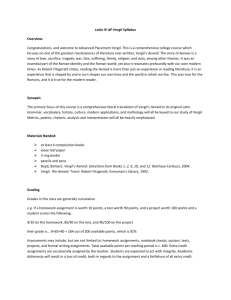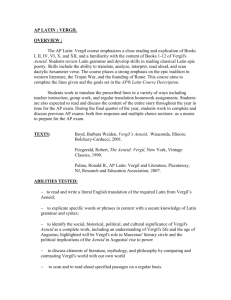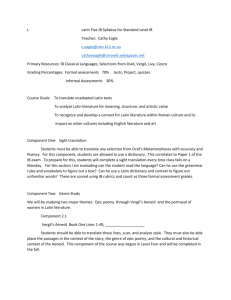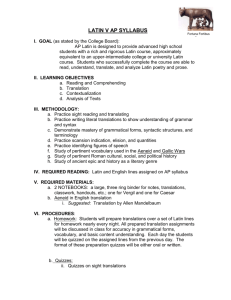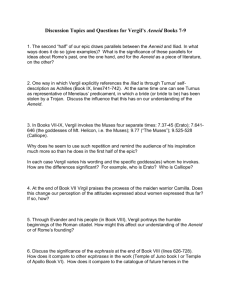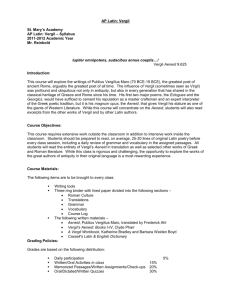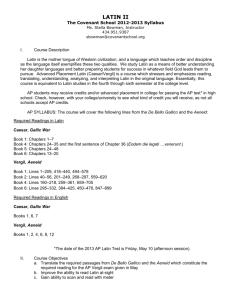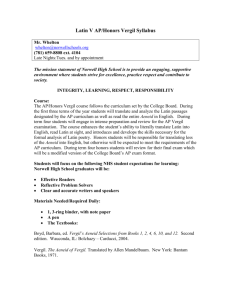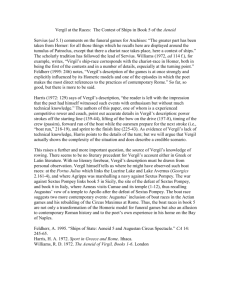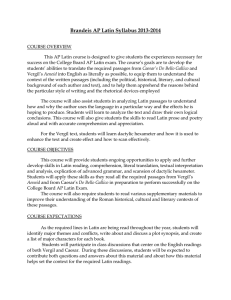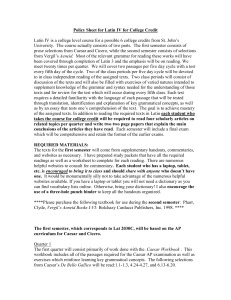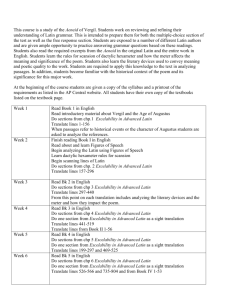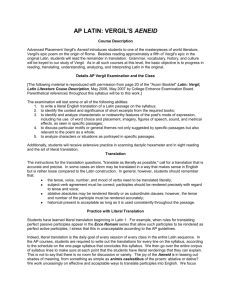LATIN V AP V ERGIL SYLLABUS
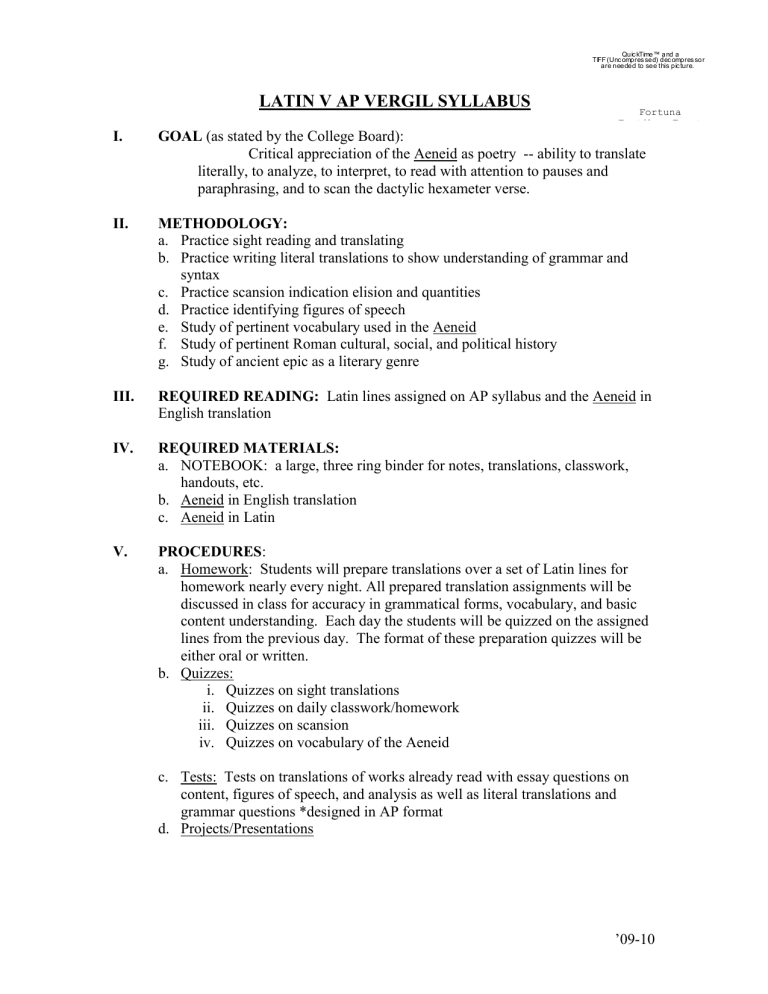
Quic kTime™ and a
TIFF (Unc ompres sed) dec ompres sor are needed to see t his pic ture.
LATIN V AP VERGIL SYLLABUS
Fortuna
Fortibus Favet
I. GOAL (as stated by the College Board):
Critical appreciation of the Aeneid as poetry -- ability to translate literally, to analyze, to interpret, to read with attention to pauses and paraphrasing, and to scan the dactylic hexameter verse.
II.
METHODOLOGY: a.
Practice sight reading and translating b.
Practice writing literal translations to show understanding of grammar and syntax c.
Practice scansion indication elision and quantities d.
Practice identifying figures of speech e.
Study of pertinent vocabulary used in the Aeneid f.
Study of pertinent Roman cultural, social, and political history g.
Study of ancient epic as a literary genre
III.
REQUIRED READING: Latin lines assigned on AP syllabus and the Aeneid in
English translation
IV.
REQUIRED MATERIALS: a.
NOTEBOOK: a large, three ring binder for notes, translations, classwork, handouts, etc. b.
Aeneid in English translation c.
Aeneid in Latin
V.
PROCEDURES : a.
Homework: Students will prepare translations over a set of Latin lines for homework nearly every night. All prepared translation assignments will be discussed in class for accuracy in grammatical forms, vocabulary, and basic content understanding. Each day the students will be quizzed on the assigned lines from the previous day. The format of these preparation quizzes will be either oral or written. b.
Quizzes: i.
Quizzes on sight translations ii.
Quizzes on daily classwork/homework iii.
Quizzes on scansion iv.
Quizzes on vocabulary of the Aeneid c.
Tests: Tests on translations of works already read with essay questions on content, figures of speech, and analysis as well as literal translations and grammar questions *designed in AP format d.
Projects/Presentations
’09-10
AP VERGIL EXAM
The AP Vergil Exam tests students ability to1) write a literal translation of a Latin passage on the syllabus, 2) explain specific words or phrases in context, 3) identify context and significance of short excerpts from the syllabus, 4) identify and analyze characteristic or noteworthy features of the poet’s manner of expression, including use of word choice and placement, imagery, figures of speech, sound and metrical effects in certain passages, 5) discuss themes in specific passages and their relevancy to the whole poem, and 6) analyze characters or situations in specific passages.
A student must convince the reader that he/she is drawing conclusions or support from the Latin text and not from a general recall of the passage. Therefore, the student must write out the Latin lines, accurately translate or paraphrase, and discuss on the freeresponse section of the exam.
The Chief Reader of the AP Latin Exam states : “Students need to understand that paraphrase or description is not synonymous with real literary analysis….Those who succeed read Latin well, have developed a real sense of the author, understand the cultural context of the work, and may well have formulated original interpretations that caused the readers to reconsider their own understanding of the literature.”
SYLLABUS
Book 1: lines 1-519
Book 2: lines 1-56, 199-297, 469-566, and 735-805
Book 4: lines 1-448 and 642-705
Book 6: lines 1-211, 450-476, and 847-901
Book 10: lines 420-509
Book 12: lines 791-842 and 887-952
Total number of lines: 1856
Students must also read the Aeneid in English and be familiar with its entire content. In addition, students are expected to be familiar with the background of Vergil’s life as well as pertinent Roman cultural, social, and political history. The course also requires a student to be able to scan dactylic hexameter and to be familiar with the figures of speech commonly use by Vergil in the Aeneid.
EXAM
The Advanced Placement Exam consists of two parts. The first part is a multiple-choice section, which tests students’ ability to read and understand Latin poetry and prose AT
SIGHT. This sections consists of four passages (3 sight and 1 syllabus-based), contains
50 multiple choice questions, and is 60 minutes long. The second part of the exam is a free-response section on the Vergil syllabus, which measures students’ ability to comprehend, analyze, and interpret the literature read in the course. This section consists of five questions and is one hour and 45 minutes long.
’09-10
’09-10
